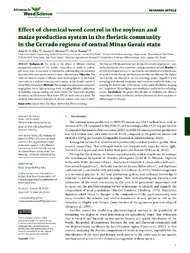Effect of chemical weed control in the soybean and maize production system in the floristic community in the Cerrado regions of central Minas Gerais state.
Effect of chemical weed control in the soybean and maize production system in the floristic community in the Cerrado regions of central Minas Gerais state.
Author(s): SILVA, J. R. O.; MENDES, K. F.; KARAM, D.
Summary: Background: The study of the effects of different chemical management practices on the floristic composition of weeds in soybean and maize crops in succession is essential for understanding the population dynamics of the main species present in these cultivated areas. Objective: This study evaluated the impact of different weed control programs on the floristic community in a soybean-maize succession system, in the Cerrado regions of central Minas Gerais state. Methods: Five management systems were compared, ranging from low to high technology levels, including different combinations of herbicides, manual weeding, and winter fallow. The frequencies, densities, dominance, and Importance Value Index (IVI) of weeds were calculated. The similarity index between treatments in the two soybean crops was calculated. Dry biomass (DB) data and total plant density of Commelina benghalensis L. were analyzed at the end of the experiment using geostatistical methods. Results: In all phytosociological surveys, 31 weed species were identified. A predominance of weeds from the Poaceae and Asteraceae families was observed. The highest weed density was observed in the low technology system. Regardless of the technology level adopted, the greatest weed control occurred in the maize crop, reducing the total biomass of the species. In the spatial distribution mapping of C. benghalensis DB, the highest concentration occurred in the low technology system. Conclusions: The greater diversification of herbicides with different mechanisms of action provides less similarity between the weed population in different agricultural crops.
Publication year: 2024
Types of publication: Journal article
Unit: Embrapa Maize & Sorghum
Keywords: Cerrado, Controle Químico, Erva Daninha, Fitossociologia, Glycine Max, Herbicida, Herbicides, Phytosociology, Zea Mays
Observation
Some of Embrapa's publications are published as ePub files. To read them, use or download one of the following free software options to your computer or mobile device. Android: Google Play Books; IOS: iBooks; Windows and Linux: Calibre.
Access other publications
Access the Agricultural Research Database (BDPA) to consult Embrapa's full library collection and records.
Visit Embrapa Bookstore to purchase books and other publications sold by Embrapa.

